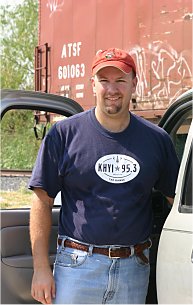Lake Valley ghost town
Friday, November 7. Before heading back to Texas, Miss C. and I visited the ghost town of Lake Valley, NM. I had been wanting to visit it for several years, but had never made it out there before. It was definitely worth the trip; I've visited ghost towns throughout Texas and New Mexico, and Lake Valley is one of the best-preserved sites I've seen.
 Lake Valley, NM
Lake Valley, NM
The site today is owned and managed by the BLM (Bureau of Land Management). If you visit, be sure to stop at the schoolhouse, where you'll find a small museum collection of photographs and artifacts. You can also pick up a map and guide for a self-guided walking tour for the townsite. Historical markers are located throughout the town near points of interest, and complement the information in the guide. At the time of this writing, the entire site is closed on Tuesdays and Wednesdays, so be sure to check before visiting:
http://www.blm.gov/nm/st/en/prog/recreation/las_cruces/lake_valley_townsite.html
 In 1895, two years after the mining boom subsided, a fire devastated a substantial portion of Lake Valley's downtown area. This old bank safe still stands near its original location.
In 1895, two years after the mining boom subsided, a fire devastated a substantial portion of Lake Valley's downtown area. This old bank safe still stands near its original location.
Of course there is a railroad angle, hence my interest in visiting the area. In 1884, the railroad constructed a 13-mile branch line from Nutt (on the main line between Hatch and Deming) to Lake Valley. Although the line was abandoned in 1934, even today, the right of way is visible in many locations between the two townsites. A number of structures remain standing at Lake Valley.
 Unfortunately, some portions of the Lake Valley site are off limits to visitors. The Lake Valley railroad station stands just beyond this gate.
Unfortunately, some portions of the Lake Valley site are off limits to visitors. The Lake Valley railroad station stands just beyond this gate.
 We spent some time visiting with the caretaker, who lives in a travel trailer behind the Lake Valley school house. He showed us a selection of students' drawings and pictures, believed to have been made in the 1940s.
We spent some time visiting with the caretaker, who lives in a travel trailer behind the Lake Valley school house. He showed us a selection of students' drawings and pictures, believed to have been made in the 1940s.
 Landscape east of Lake Valley, NM.
Landscape east of Lake Valley, NM.
 Lake Valley, NM
Lake Valley, NMLocated west of Hatch, east of Silver City, north of Deming, and south of Hillsboro, Lake Valley got its start when silver was discovered in the area in 1878. The town's population swelled to around 4,000 residents before the mining boom began to die down in 1893. Over the next century, Lake Valley's population slowly dwindled until the town's last full-time residents moved away in 1994.
The site today is owned and managed by the BLM (Bureau of Land Management). If you visit, be sure to stop at the schoolhouse, where you'll find a small museum collection of photographs and artifacts. You can also pick up a map and guide for a self-guided walking tour for the townsite. Historical markers are located throughout the town near points of interest, and complement the information in the guide. At the time of this writing, the entire site is closed on Tuesdays and Wednesdays, so be sure to check before visiting:
http://www.blm.gov/nm/st/en/prog/recreation/las_cruces/lake_valley_townsite.html
 In 1895, two years after the mining boom subsided, a fire devastated a substantial portion of Lake Valley's downtown area. This old bank safe still stands near its original location.
In 1895, two years after the mining boom subsided, a fire devastated a substantial portion of Lake Valley's downtown area. This old bank safe still stands near its original location.Of course there is a railroad angle, hence my interest in visiting the area. In 1884, the railroad constructed a 13-mile branch line from Nutt (on the main line between Hatch and Deming) to Lake Valley. Although the line was abandoned in 1934, even today, the right of way is visible in many locations between the two townsites. A number of structures remain standing at Lake Valley.
 Unfortunately, some portions of the Lake Valley site are off limits to visitors. The Lake Valley railroad station stands just beyond this gate.
Unfortunately, some portions of the Lake Valley site are off limits to visitors. The Lake Valley railroad station stands just beyond this gate.  We spent some time visiting with the caretaker, who lives in a travel trailer behind the Lake Valley school house. He showed us a selection of students' drawings and pictures, believed to have been made in the 1940s.
We spent some time visiting with the caretaker, who lives in a travel trailer behind the Lake Valley school house. He showed us a selection of students' drawings and pictures, believed to have been made in the 1940s.  Landscape east of Lake Valley, NM.
Landscape east of Lake Valley, NM. Coming next... heading back to Texas. Check back soon...
WSC
np: Hank Williams - "First year blues"
WSC
np: Hank Williams - "First year blues"
Labels: ghost town, Lake Valley New Mexico, road trip







2 Comments:
dude, must've been some small locomotive to use those water towers. . .sure they aren't for other uses?
A cool place, off the beaten path. Thanks for the visit!
Well, it's certainly possible that a larger tank once stood atop that platform...
The line saw only light traffic (a daily mixed from Rincon) and tonnages -- including locomotive weight -- were limited due to the use of lightweight rail, so a small tower would presumably have been sufficient.
Wait til you see what they've done with the TOYAH water tower... coming next...
WSC
Post a Comment
<< Home